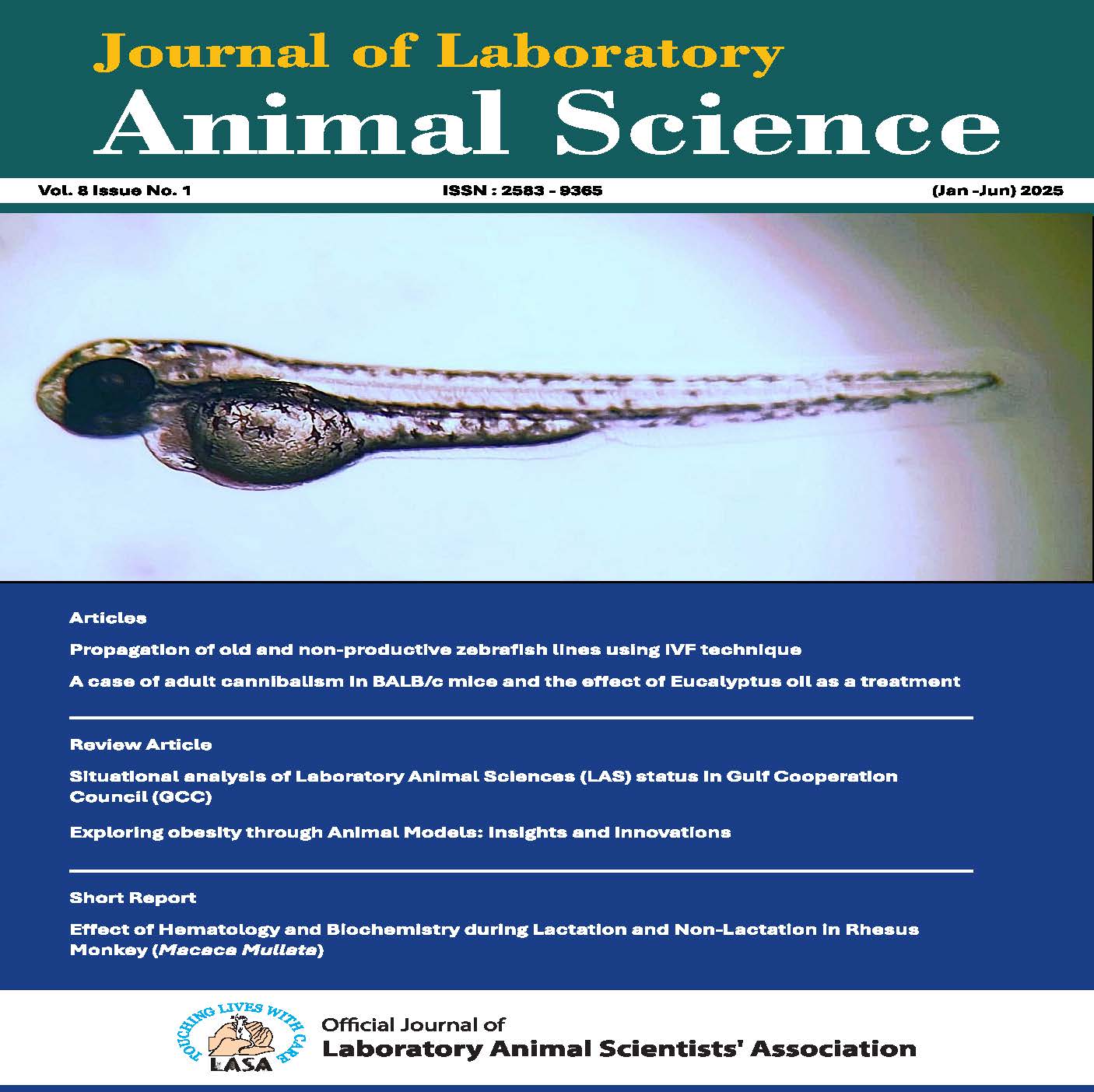Hematological values of mice and rat strains : Perspectives from ACTREC Laboratory Animal Facility
DOI:
https://doi.org/10.48165/jlas.2019.1.1.13Keywords:
laboratory animals, hematology, rats, miceAbstract
Experimental results of the hematological or biochemical data are best interpreted and compared based on previously reported baseline data for the strains in question. Maintenance and managemental conditions of the animals varies from organization to organization. Naturally, the baseline data for hematology and biochemistry may vary amongst the same species or strains of animals. This study was undertaken to establish hematological reference values in mice and rat strains maintained at Advanced Centre for Treatment, Research and Education in Cancer (ACTREC), Navi Mumbai and to compare with that of the values reported by other workers as in the literature. Hematological values were found to be within the normal range when compared to the values reported in the literature. Slight deviations in these values have been noticed within the strain. However, they remain within the reported normal range. Most of the time, the normal range values were so wide that it necessitates the need for the laboratory-specific baseline data. The wide range may be the result of genetic changes, change in feed, housing conditions, technique and equipments used or management conditions. The hematological values of these strains may provide valuable baseline data to the researchers for future experiments using these inbred strains.
Downloads
References
Aiso S, Arito H, Nishizawa T, Nagano K, Yamamoto S, Matsushima T (2005). Thirteen-week inhalation toxicity of p-Dichlorobenzene in mice and rat. J. Occup. Health. 47: 249- 260.
Alter B, Kan Y, Nathan D (1974). Toxic effect of high-dose Cyanate administration in rats. Blood. 43(1): 69- 77.
Bhardwaj K (1992). National Laboratory Animal Center News Letter Rat, No. 2, Central Drug Research Institute, Lucknow: 1-10.
Bhilegaonkar D, Deshpande B, Degloorkar N, Moregaonkar S, Vadamudi V, Rajurkar S (1995). Hematobiochemical Studies in sub-acute Benfuracarb Toxicity in Rats. Ind. J. Vet. Pathol. 19(1): 15-18.
Charles River Laboratories Technical Bulletin for Wistar Rats (1982). Baseline hematology and clinical chemistry values for Wistar rats as a function of sex and age vol. 1, No. 2, Wilmington, Massachusetts.
Charles River Laboratories Technical Bulletin for F-344 Rats (1984). Baseline hematology and clinical chemistry values for F-344 rats as a function of sex and age, vol. 3, No. 1, Wilmington, Massachusetts, USA.
Charles River Laboratories Technical Bulletin for CD-1 mice. Summer (1986). Baseline hematology and clinical chemistry values for CD-1 mice as a function of sex and age Wilmington, Massachusetts, USA.
CPCSEA Guidelines for Laboratory Animal Facility (2008). II edn., Chennai. pp 12- 13.
Festing MFW (1979). In: Inbred Strains in Biomedical Research, The Macmillan Press Ltd. London. pp 1-20.
Giknis MLA (2008). Clinical Laboratory Parameters for Crl:WI(Han) rats. Charles River Laboratories, USA.
Green EL (1966). In: Biology of Laboratory Animals, 2nd edn., The Blakeston Dit, New York. pp 352-353.
Hariharan S (1979). The Mouse- Care, breeding and management. Laboratory Animals Information Service Center News. National Institute of Nutrition, Hyderabad No. 2: 14.
Hariharan S (1980). The Laboratory Rat, Laboratory Animals Information Service Center News. National Institute of Nutrition, Hyderabad, No. 3.
Harrison S, Burdeshaw J, Crosby R, Cusic A, Denine E (1978). Hematology and Clinical Chemistry Reference Values for C57BL/6 x DBA/2 F1 Mice. Cancer Res. 38: 2636-2639.
Hematological values in rodents, Ingle A.D.
Hejtmancik M, Ryan M, Toft J, Persing R, Kurtz P, Chhabra R (2002). Hematological Effects in F344 Rats and B6C3F1 Mice during the 13-Week Gavage Toxicity Study of Methylene Blue Trihydrate. Toxicol. Sci. 65: 126–134.
Jonkar D, Till H (1995). Human Diets Cooked by Microwave or Conventionally: Comparative sub chronic (13-wk) Toxicity Study in Rats. Fd. Chem. Toxic. vol. 33, No. 4: 245-256.
Kawabe M, Tamano S, Shibata M, Hirose M, Fukushima S, Ito N (1993). Subchronic toxicity study of methyl hesperidine in mice. Toxicol Letters. 69: 37-44.
Lang P (1993). Hematology parameters for the Crl:CDBR rats, Charles River Laboratories Technical Bulletin for Crl: CDBR Rats. vol. 3, No. 1, Wilmington, Massachusetts, USA.
Lovell D, Archer R, Riley J, Morgan R (1981). Variation in haematological parameters among inbred strains of rat. Lab. Anim. 15: 243-249.
Merchant M, Modi D (2004). Acute and chronic effects of aspirin on hematological parameters and hepatic ferritin expression in mice. Indian J Pharmacol. Vol 36, issue 4: 226-230.
Randelia H, Sanghvi L (1961). ‘Bare’, a new hairless mutant in the mouse-genetics and histology. Genet. Res. 2: 283- 289.
Saibaba P, Urs J, Lokesh B, Suresh T (1995). Hematological data of Indian desert Gerbil. Lab. Anim. India. vol. 4, No. 2: 83-91.
Stana L, Trif A, Petrovici S, Stana L, Petcu M (2009). Comparative Study Regarding the Potassium
Dichromate Influence on the Resistance of Erythrocyte Membrane in Female Rats in Accordance with the Dose and Exposing Life Period. Lucrari Stiinłifice Medicina Veterinara. Vol. XLII (2): 286- 90.
Thrall MA (2004) Mammalian Hematologic: Laboratory Animals and Miscellaneous Species. In: Veterinary Hematology and Clinical Chemistry, Ed. DB Troy, Lippincott Williams and Wilkins, Philadelphia. pp 211- 224.
Walter G (1999). Effect of Carbon Dioxide inhalation on Hematology, Coagulation and Serum Clinical Chemistry in Rats. Toxicol Pathol. Vol 27, no. 2: 217- 225.
Waynforth H (1980). Experimental and Surgical Techniques in Rats, Academic Press, London: 240.
Weber D, Danielson K, Wright S, Foley J (2002). Hematology and Serum Biochemistry Values of Dusky Footed Wood Rat (Neotoma Fuscipes). J. Wildlife Diseases. 38 (3): 576– 582.

